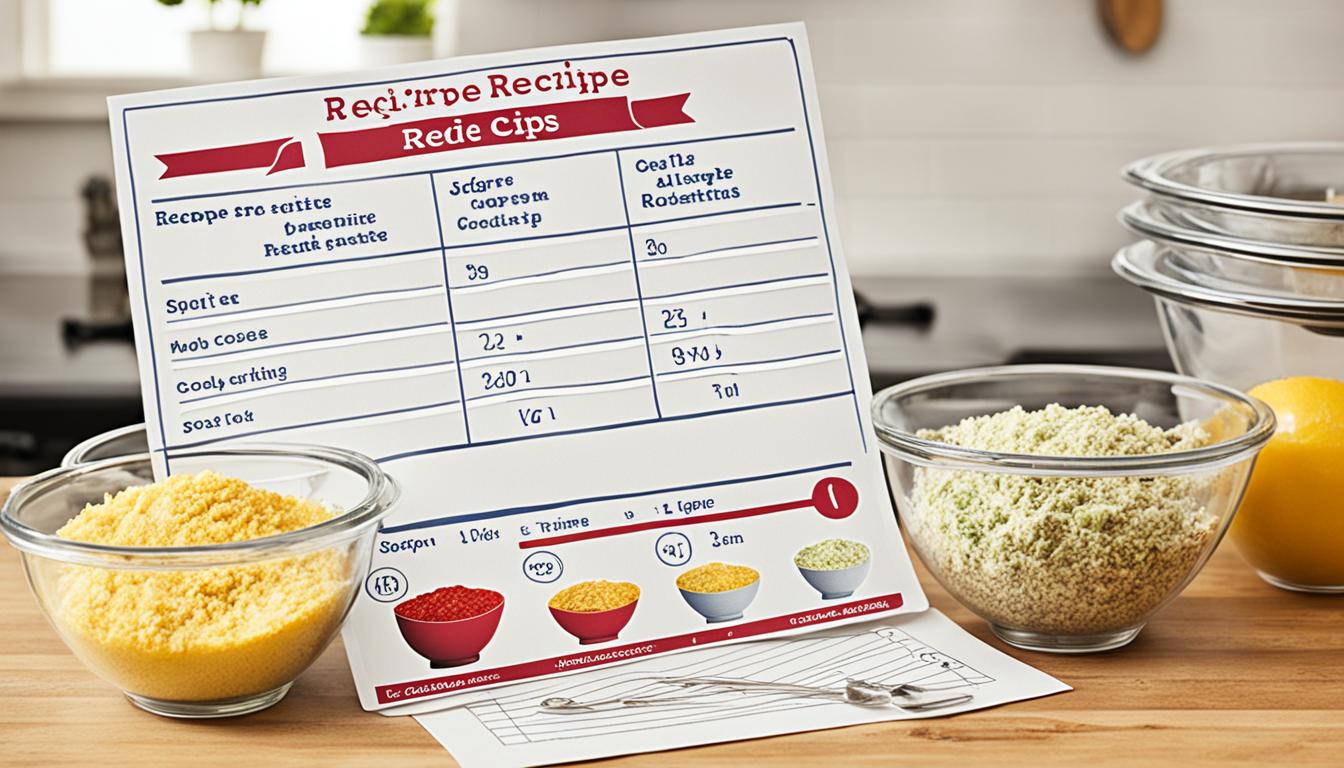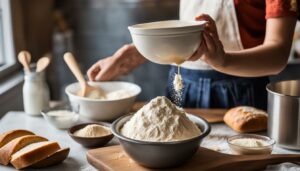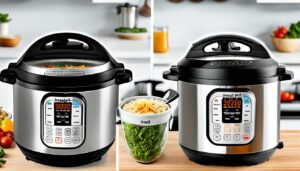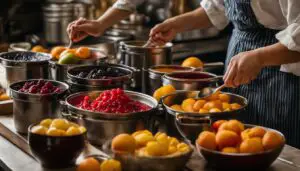Originally posted on March 26, 2024 @ 7:48 pm
When it comes to cooking, we all love to experiment and try new recipes. But what happens when we need to double a recipe to serve a larger group or prepare meals in advance? Does doubling a recipe mean we’ll need to spend double the time in the kitchen? Let’s find out!
Contents
- 1 Why Adjustments Are Necessary When Doubling a Recipe
- 2 How to Double a Recipe
- 3 Considerations When Doubling Spices in a Recipe
- 4 Choosing the Right Dish Size for Doubled Recipes
- 5 How Cooking and Baking Times Are Affected by Doubling a Recipe
- 6 Recipes That Can Be Doubled
- 7 Doubling Recipes for Meal Prep
- 8 Tripling a Recipe
- 9 Halving a Recipe
- 10 Adjusting Spices and Leaveners in Baking Recipes
- 11 Conclusion
- 12 FAQ
- 12.1 Does doubling a recipe double the cooking time?
- 12.2 Why are adjustments necessary when doubling a recipe?
- 12.3 How do I double a recipe?
- 12.4 What about doubling spices in a recipe?
- 12.5 How do I choose the right dish size for doubled recipes?
- 12.6 How are cooking and baking times affected by doubling a recipe?
- 12.7 Which recipes can be doubled?
- 12.8 Can I double recipes for meal prep?
- 12.9 How do I triple a recipe?
- 12.10 How do I halve a recipe?
- 12.11 How should I adjust spices and leaveners when scaling up baking recipes?
- 12.12 What are some tips for successfully doubling recipes?
- 13 Source Links
Key Takeaways:
- Doubling a recipe requires adjustments to ingredient amounts, cooking tools, and cooking time to ensure even and thorough cooking.
- Choosing the right dish size is crucial when doubling recipes to avoid overcrowding and uneven cooking.
- Spices should be adjusted properly when doubling a recipe to avoid overpowering the dish.
- Cooking and baking times may not always double when doubling a recipe, and it’s important to check for doneness at the recommended time.
- Doubling recipes can be a time-saving strategy for meal prep, but it’s essential to make the necessary adjustments for successful scaling.
Why Adjustments Are Necessary When Doubling a Recipe
When it comes to doubling a recipe, it’s not as simple as just doubling the ingredients. Adjustments need to be made to ensure that the dish turns out perfectly. Let’s explore why these adjustments are necessary and what they entail.
Modifying Ingredient Amounts:
When doubling a recipe, the quantity of each ingredient needs to be adjusted accordingly. This is crucial to maintain the right flavor balance and consistency. For example, if the original recipe calls for 1 cup of flour, you would need to use 2 cups when doubling the recipe.
Changes to Cooking Time:
Along with ingredient quantities, the cooking time may also need to be adjusted. When you double the volume of a dish, it may take longer to cook or bake evenly. Keep an eye on the cooking progress and be prepared to increase the cooking time if needed. However, it’s important to note that not all recipes require double the original cooking time.
“Doubling a recipe doesn’t necessarily mean doubling the cooking time. You have to consider factors like the type of dish, oven temperature, and the size of your cooking vessel.” – Chef Sarah Thompson
| Recipe Adjustment | Original Recipe Quantity | Doubled Recipe Quantity |
|---|---|---|
| Flour | 1 cup | 2 cups |
| Sugar | 1/2 cup | 1 cup |
| Baking Powder | 1 teaspoon | 2 teaspoons |
| Cooking Time | 30 minutes | Check for doneness and adjust as needed |
Adjusting the Size of Preparation Tools, Pots, or Pans:
When doubling a recipe, you might find that your usual mixing bowls or pots are too small to accommodate the increased volume. To avoid overflow and ensure efficient mixing, use larger kitchen tools suitable for the doubled quantity.
By making these adjustments, you can ensure that your doubled recipe turns out just as delicious as the original. Remember to taste and adjust seasonings as needed to account for the increased quantities.
Next: How to Double a Recipe
How to Double a Recipe
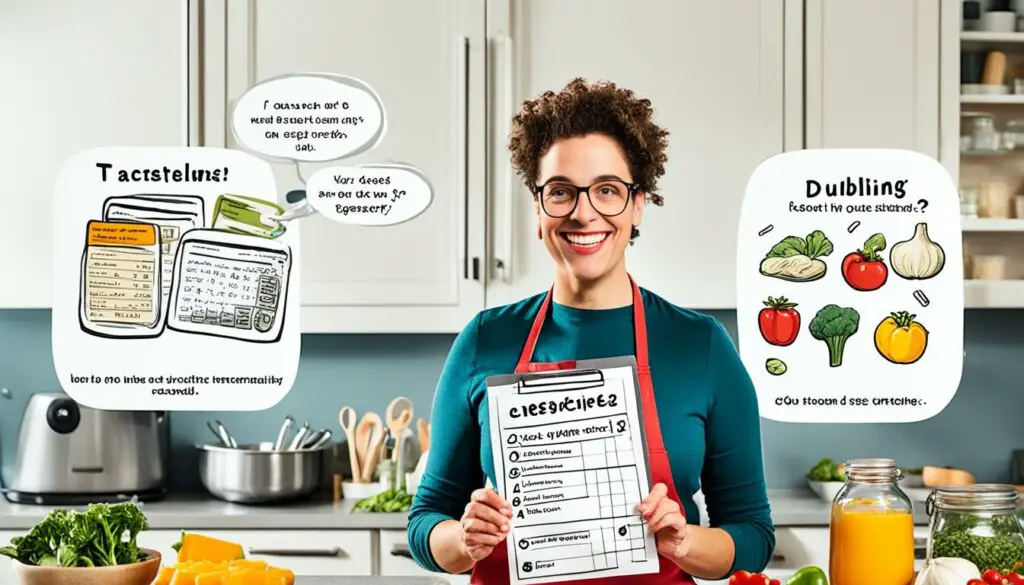
When it comes to cooking for larger groups or meal prepping, doubling a recipe can be a game-changer. However, it’s important to know the right techniques to ensure your doubled recipe turns out just as delicious as the original. In this section, we’ll guide you through the process of doubling a recipe, from scaling ingredient quantities to adjusting cooking times.
Calculating Ingredient Measurements
To double a recipe, the first step is to calculate the new measurements for each ingredient. This ensures that the flavors and textures of your dish remain balanced. You can use a calculator or an online tool to make accurate conversions. For example, if the original recipe calls for 1 cup of flour, you would need 2 cups for the doubled recipe.
Choosing the Right Mixing Bowls
Before you start preparing your doubled recipe, make sure you have the right mixing bowls to accommodate twice the amount of ingredients. It’s essential to have bowls that are large enough to hold all the components comfortably. This will make the mixing process easier and prevent any spills or messes. Consider investing in high-quality, spacious mixing bowls to make your cooking experience more efficient.
Adjusting Cooking Times
When you double a recipe, it’s crucial to adjust the cooking time to ensure an even bake or cook throughout. The increased quantity of ingredients may take longer to heat and cook properly. Keep in mind that the cooking time adjustment might not be a straightforward double of the original recipe’s cooking time. Factors such as the type of dish, oven temperature, and size of the baking pan can influence the cooking time. It’s best to follow the recommended cooking time as a starting point and then check for doneness at regular intervals. Make small adjustments as needed until your dish is perfectly cooked.
By following these steps, you’ll be able to successfully double your favorite recipes and cater to larger gatherings or future meals. Doubling a recipe doesn’t have to be intimidating. With the right techniques, you can confidently create double portions that are just as tasty as the original. Now, let’s explore some considerations when it comes to doubling spices in a recipe.
Considerations When Doubling Spices in a Recipe
When it comes to doubling spices in a recipe, it’s important to proceed with caution. While the instinct may be to simply double the spice amounts along with the other ingredients, doing so can easily result in an overpowering flavor that throws off the balance of the dish. To avoid this, a more measured approach is necessary.
Instead of doubling the spices outright, a good rule of thumb is to start by multiplying them by 1.5. This allows for a noticeable increase in flavor without overwhelming the other ingredients. It’s always easier to add more spices later if needed, but it’s difficult to tone down an overly spicy dish.
Another helpful tip is to conduct taste tests throughout the cooking process. Taste the dish after adding the initial amount of spices, and then adjust accordingly. This way, you can gradually build up the flavors to your liking without going overboard.
Pro Tip: It’s essential to remember that spices can vary in intensity, so it’s wise to use your judgment and adjust accordingly based on the specific recipe and your personal taste preferences.
By taking these considerations into account, you can ensure that the doubled recipe maintains a harmonious balance of flavors and avoids any unpleasant surprises. Now let’s move on to the next section to learn about choosing the right dish size when doubling recipes.
Choosing the Right Dish Size for Doubled Recipes

When doubling a recipe, one important consideration is the dish size. Using the appropriate baking pans or stock pots ensures that the dish cooks evenly and allows for proper expansion during the cooking process.
For doubled recipes that require baking, it’s crucial to select the right size baking pan that can accommodate the increased quantity of ingredients. Using a smaller pan may result in overcrowding, causing the dish to cook unevenly or overflow. On the other hand, using a larger pan than necessary may lead to the dish spreading too thin and cooking too quickly.
Here’s a general guide for selecting the appropriate baking pan size when doubling a recipe:
| Original Recipe Dish Size | Doubled Recipe Dish Size |
|---|---|
| 8-inch round cake pan | 9×13-inch baking pan |
| 9-inch square baking pan | 9×13-inch baking pan |
| 9×5-inch loaf pan | 2 9×5-inch loaf pans |
| 9-inch pie plate | 9×13-inch baking pan |
If the appropriate baking pan size is not available, an alternative is to cook the doubled recipe in smaller batches. This ensures that each batch cooks evenly and allows for better control of the cooking process. Remember to adjust the cooking time accordingly when cooking in smaller batches.
For stovetop cooking, using a stock pot is recommended when doubling a recipe. A stock pot with a larger capacity can accommodate the increased quantity of ingredients and provide ample space for stirring and simmering.
By choosing the right dish size, whether it’s a baking pan or stock pot, you can ensure that your doubled recipes turn out delicious and evenly cooked.
Check out the visually appealing image below that showcases the appropriate dish sizes for doubled recipes:
How Cooking and Baking Times Are Affected by Doubling a Recipe

When doubling a recipe, you may assume that the cooking or baking time must also be doubled. However, that is not always the case. The cooking and baking times are influenced by various factors, such as the size and type of dish used. Let’s explore how to determine the appropriate cooking times when doubling a recipe.
First, it is crucial to check for doneness at the time indicated in the original recipe. This initial cooking or baking time serves as a baseline. Use a toothpick or skewer to test if the dish is cooked through. If the toothpick comes out clean or with a few crumbs, the dish is usually done. However, if it comes out with raw batter or crumbs sticking to it, the dish needs more time.
After the initial cooking or baking time, it’s important to check for doneness at regular intervals, typically every 5 minutes. Keep in mind that larger quantities may require slightly more time to cook or bake evenly. By checking for doneness at regular intervals, you can prevent overcooking or undercooking the dish.
The size and type of dish used also play a role in determining the cooking time when doubling a recipe. For example, a deeper baking dish may require slightly more time compared to a shallower dish. It’s essential to consider these factors and make adjustments accordingly.
Remember, recipes are guidelines, and the cooking or baking time provided is an estimate. It’s vital to rely on your senses and visual cues to ensure that the dish is cooked through. Trust your instincts and make adjustments as needed.
“Cooking times may vary based on the size and type of dish used.”
Recipes That Can Be Doubled
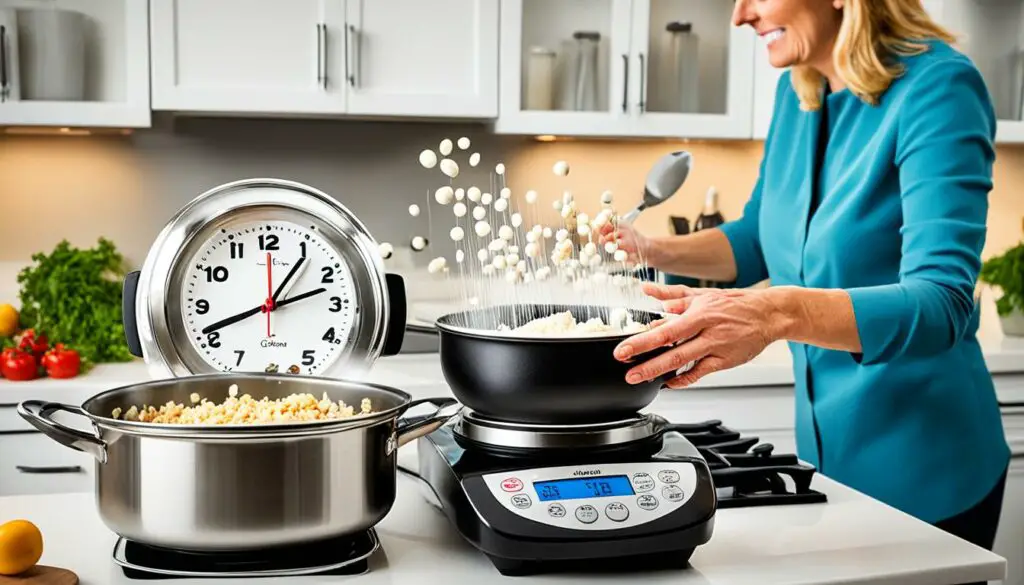
Are you hosting a dinner party or need to prepare a large quantity of food? Doubling a recipe can be a convenient solution. Whether you’re looking to scale up baked goods or increase portions of your favorite meals, many recipes lend themselves well to doubling.
Let’s explore some popular recipes that can easily be doubled:
- Cakes and Cookies: Baking delicious treats like cakes and cookies? These recipes often require common ingredients like flour, sugar, and butter, making them ideal candidates for doubling. Simply adjust the ingredient quantities, mix the batter, and bake it all at once.
- Stews and Casseroles: Love hearty stews and comforting casseroles? These dishes are perfect for doubling to feed a large group. Whether it’s a classic beef stew or a cheesy lasagna, you can increase the portions without compromising on flavor.
- Pasta Dishes: Planning a pasta night? Pasta recipes, such as spaghetti Bolognese or carbonara, can be easily doubled to accommodate more servings. Just cook a larger quantity of pasta and adjust the sauce ingredients accordingly.
- Chili and Soups: Warm up a crowd with a big batch of chili or soup. These recipes often require simple ingredients like beans, vegetables, and spices, which can be easily scaled up. Doubling the recipe allows for plenty of leftovers or seconds for everyone to enjoy.
“By doubling recipes, you can create larger quantities of your favorite dishes and accommodate more people at your table.”
Remember, when doubling a recipe, it’s important to make the necessary adjustments to ingredient quantities and cooking times. Take into account the size of your cooking equipment and ensure thorough mixing of the ingredients for even distribution.
Feel free to experiment with different recipes and share the joy of delicious meals with your loved ones. Doubling a recipe not only saves time but also allows for easy meal planning and preparation. So go ahead, scale up your favorite dishes, and enjoy the benefits of cooking in larger quantities!
Doubling Recipes for Meal Prep
When it comes to meal prep, efficiency is key. Doubling recipes is a fantastic strategy that allows you to save time on busy days and always have prepared ingredients on hand. By preparing ingredients in advance and doubling the recipe quantities, you can easily create extra portions for future meals. Let’s explore how doubling recipes for meal prep can help you save time and make your life in the kitchen a breeze!
Preparing ingredients in advance is a game-changer when it comes to efficient meal prep. By doubling recipes, you can chop, slice, and measure ingredients all at once, minimizing the time spent in the kitchen on busy days. Whether you’re prepping vegetables for a hearty stir-fry or marinating meat for a delicious barbecue, having everything ready in advance ensures a seamless cooking process.
Not only does doubling recipes save time in the moment, but it also allows you to plan ahead. With extra portions prepared, you can stock your freezer with ready-to-eat meals or assemble meal kits that can be conveniently cooked throughout the week. This means you can enjoy homemade meals even on days when you’re short on time or energy.
Another advantage of doubling recipes is the opportunity to experiment with flavors and ingredients. When you have double the quantity of a recipe, you can divide it into separate batches and add different spices or seasonings to each one. This way, you can create multiple variations of a dish, catering to different taste preferences or dietary restrictions.
Meal prep doesn’t have to be a daunting task. By doubling recipes and preparing ingredients in advance, you can save time, reduce stress, and enjoy delicious homemade meals throughout the week.
When it comes to meal prep efficiency, organization is key. Here are a few tips to help you get started:
- Choose recipes that are well-suited for doubling, such as casseroles, soups, or pasta dishes.
- Invest in quality food storage containers that are freezer-safe and portion-sized for easy grab-and-go meals.
- Create a meal plan and grocery list to ensure you have all the necessary ingredients on hand.
- Set aside dedicated meal prep days to tackle multiple recipes at once.
- Label your prepared meals or meal kits with the date and contents for easy identification in the freezer.
With these tips in mind, let’s take a look at a sample meal prep plan to demonstrate the time-saving benefits of doubling recipes:
| Day | Meal | Recipe |
|---|---|---|
| Monday | Lunch | Quinoa Salad with Roasted Veggies |
| Tuesday | Dinner | Beef Stir-Fry with Rice |
| Wednesday | Lunch | Chicken Caesar Wraps |
| Thursday | Dinner | Teriyaki Salmon with Steamed Broccoli |
| Friday | Lunch | Black Bean Burrito Bowls |
By doubling the recipes for the Quinoa Salad with Roasted Veggies, Beef Stir-Fry with Rice, Chicken Caesar Wraps, Teriyaki Salmon with Steamed Broccoli, and Black Bean Burrito Bowls, you can easily prepare two servings of each meal for the entire week. This not only saves time on cooking and meal planning but also prevents the temptation to order takeout when you’re too busy to cook.
So, why spend extra time in the kitchen when you can double recipes for meal prep and enjoy the convenience of ready-to-eat meals? Give it a try and experience the time-saving benefits for yourself!
Tripling a Recipe
Tripling a recipe can be a great option when preparing meals for larger gatherings or events. However, it requires some additional considerations and techniques compared to doubling a recipe. In this section, we will explore how to triple a recipe effectively, the challenges of working with larger quantities, and the use of multiple bowls for improved efficiency.
How to Triple a Recipe
To triple a recipe, you need to multiply all the ingredients by three. It is essential to use accurate measurements and a reliable recipe calculation tool to ensure the correct proportions. Remember to adjust the cooking time accordingly based on the original recipe’s recommended cooking time.
Here’s a step-by-step guide on how to triple a recipe:
- Gather the original recipe and identify the required quantities of each ingredient.
- Multiply each ingredient’s measurement by three to obtain the new quantities.
- Prepare the necessary tools and equipment, such as larger mixing bowls and pans, to accommodate the increased amount of ingredients.
- Follow the original recipe instructions for combining the ingredients, ensuring thorough mixing to maintain consistency.
- Adjust the cooking time as needed, considering factors like oven temperature and the type of dish used.
- Check for doneness by following the original recipe’s instructions and visually assessing the dish’s appearance and texture.
- Enjoy your tripled recipe and share it with family and friends!
Challenges of Working with Larger Quantities
Working with larger quantities can pose some challenges during the cooking and preparation process. Below are a few common challenges and tips on how to overcome them:
| Challenges | Tips |
|---|---|
| Difficulty in achieving uniform seasoning | Use measuring spoons and cups accurately to ensure consistent seasoning throughout the dish. Taste and adjust as needed. |
| Limited workspace | Organize your kitchen area before starting to create more workspace. Consider using additional countertops or tables if available. |
| Heavy lifting and handling | Use sturdy and ergonomic kitchen tools to facilitate handling and minimize strain. Ask for assistance if needed. |
| Increased cooking time | Monitor the dish closely during cooking and make necessary adjustments to ensure even heat distribution. Consider rotating pans or adjusting oven racks to maintain consistent cooking. |
Using Multiple Bowls for Efficiency
When working with larger quantities, using multiple bowls can significantly improve efficiency during preparation. Instead of constantly washing and reusing the same bowl, having additional bowls allows for simultaneous prep work and saves time.
“Using multiple bowls allows you to work on different components of the recipe without having to pause and clean the only bowl you have. This can be especially useful when there are time constraints or when juggling multiple recipes simultaneously.” – Chef Emma Thompson
Having designated bowls for specific ingredients or steps in the recipe also helps prevent cross-contamination and ensures a smoother workflow. Remember to label each bowl to avoid confusion and maintain organization throughout the cooking process.
Tripling a recipe requires careful planning, attention to detail, and efficient use of resources. By understanding the process, overcoming challenges, and utilizing multiple bowls for improved efficiency, you can successfully triple your favorite recipes to share with a larger group of people.
Halving a Recipe
Halving a recipe can be a useful technique when you need smaller portions or have limited ingredients on hand. Whether you’re cooking a meal or baking a treat, knowing how to halve a recipe allows you to create just the right amount without any waste. Here’s how to do it:
Adjusting Ingredient Measurements
When halving a recipe, it’s important to adjust the ingredient measurements accordingly. Here’s a general guide to help you:
- For liquids: Simply divide the original measurement in half. For example, if the recipe calls for 1 cup of milk, you would use 1/2 cup when halving the recipe.
- For dry ingredients: Use a kitchen scale if possible to measure half of the original amount by weight. If you don’t have a scale, you can estimate by using measuring cups or spoons.
- For eggs: If the recipe calls for an odd number of eggs, you can usually round down to the nearest whole number. For example, if the recipe calls for 3 eggs, you would use 2 eggs when halving the recipe.
Remember to be precise when halving the recipe to ensure the correct balance of flavors and textures.
Reducing Baking Times
When halving a baking recipe, it’s important to reduce the baking time to prevent overcooking. The smaller portion will require less time in the oven. As a general rule, start by reducing the baking time by about 25%. For example, if the original recipe states a baking time of 30 minutes, you would start checking for doneness around 22-23 minutes when halving the recipe.
It’s essential to monitor the recipe closely and perform the doneness tests recommended in the original instructions. A toothpick or cake tester inserted into the center should come out clean or with a few moist crumbs when the dish is fully baked.
Halving a recipe doesn’t have to be complicated. By adjusting the ingredient measurements and reducing baking times, you can confidently create delicious meals or treats in smaller portions. This technique is particularly handy when you want to try out a recipe or satisfy a craving without making too much. Enjoy experimenting with halved recipes and customize them to suit your needs!
Adjusting Spices and Leaveners in Baking Recipes
When scaling up baking recipes, it’s crucial to make the proper adjustments to spices and leaveners. This ensures that your baked goods turn out delicious and with the right texture, even when doubling or tripling the recipe. Here are some tips to help you make these adjustments:
- Scaling up spices: When increasing the quantity of spices in a recipe, it’s important to do so carefully to avoid overwhelming the dish. A general rule of thumb is to increase the amount of spices by 1.5 times the original measurement. This ensures that the flavors are enhanced without becoming overpowering. For example, if the original recipe calls for 1 teaspoon of cinnamon, you would use 1.5 teaspoons when doubling the recipe.
- Adjusting leaveners: Leaveners like baking powder and baking soda play a crucial role in the rising of baked goods. When scaling up a recipe, it’s important to consider the chemical reactions that occur during baking. As a general guideline, you may need to reduce the amount of leaveners by 1/8 teaspoon per doubling or tripling of the recipe. This prevents the baked goods from becoming too airy or collapsing. However, it’s always a good idea to check the recipe and consult trusted baking sources for specific recommendations.
“Scaling up spices and adjusting leaveners is essential in maintaining the balance of flavors and texture in your baked goods.” – Jane Baker
By adjusting spices and leaveners appropriately, you can confidently scale up your baking recipes without sacrificing quality. Experiment with different measurements and flavors to find the perfect balance for your taste. Remember to always taste-test and make notes along the way to refine your future bakes.
| Ingredient | Original Quantity | Doubled Quantity |
|---|---|---|
| Cinnamon | 1 teaspoon | 1.5 teaspoons |
| Baking Powder | 1 teaspoon | 1 1/8 teaspoons |
| Baking Soda | 1/2 teaspoon | 5/8 teaspoon |
Expert Tip: Justine’s Spice Scale
Justine Thompson, a renowned baker and author, suggests creating a personal spice scale to guide your adjustments. Assign each spice a level of intensity, such as mild, medium, or strong. By understanding the potency of each spice, you can adjust the measurements accordingly and achieve the desired flavor profile in your baked goods.
Adjusting spices and leaveners is an important aspect of scaling up baking recipes. By considering the impact of these ingredients and making the necessary adjustments, you can confidently create delicious and perfectly balanced baked goods that are sure to impress.
Conclusion
In conclusion, doubling a recipe is a fantastic way to accommodate larger portions or streamline your meal prep routine. By properly adjusting ingredient quantities, selecting the right tools and dish sizes, and making necessary changes to cooking times, you can successfully double recipes without doubling the overall cooking time. It’s all about finding the perfect balance for your needs.
When scaling up a recipe, it’s important to be mindful of the adjustments required, especially when it comes to spices and leaveners in baking recipes. Increase spicy ingredients by 1.5 times to avoid overpowering the dish, and consider reducing leaveners slightly to account for chemical reactions while baking.
Experimenting and fine-tuning the scaling process will help you perfect your doubled recipes. Remember to taste-test and adjust as needed along the way. Choose appropriate dish sizes, whether it’s larger baking pans or stock pots for stovetop cooking, to ensure even cooking and consistent results. And don’t forget that cooking times may vary depending on the size and type of dish used.
With these tips and strategies, you’ll be able to confidently double recipes, save time on meal prep, and enjoy delicious meals in larger portions. Scale up your favorite baked goods or savory dishes, and discover the joy of cooking and sharing food with family and friends.
FAQ
Does doubling a recipe double the cooking time?
No, doubling a recipe does not always double the cooking time. Cooking times may vary based on the size and type of dish used. It is important to check for doneness at the time indicated in the original recipe and then every 5 minutes until the dish is evenly cooked or baked.
Why are adjustments necessary when doubling a recipe?
Adjustments are necessary when doubling a recipe to ensure that the dish cooks evenly and thoroughly. Changes need to be made to ingredient amounts, the size of preparation tools or pans, and the cooking time.
How do I double a recipe?
To double a recipe, calculate the new measurements for each ingredient. Make sure your mixing bowls can accommodate twice the ingredients. Adjust the cooking time to ensure an even bake. Follow the steps provided in the recipe to successfully double it.
What about doubling spices in a recipe?
When doubling a recipe, instead of doubling the spices outright, start by multiplying them by 1.5 to avoid overpowering the dish. Taste test and adjust as needed.
How do I choose the right dish size for doubled recipes?
Choose a dish size that can accommodate the increased ingredients. Use larger baking pans or stock pots to ensure even cooking. If the appropriate size is not available, consider cooking in smaller batches for even results.
How are cooking and baking times affected by doubling a recipe?
Cooking times when doubling a recipe may not necessarily double. The original recipe’s indicated doneness time should be checked, and then every 5 minutes until the dish is evenly cooked or baked. Cooking times may vary based on the size and type of dish used.
Which recipes can be doubled?
Most recipes can be doubled, including baked goods and meals. Baked goods like cakes and cookies can be easily scaled up, while savory dishes like stews and casseroles can be doubled to serve more people.
Can I double recipes for meal prep?
Yes, doubling recipes is a great strategy for meal prep. By doubling recipes, you can prepare ingredients in advance and have them on hand for future dishes. This saves time and makes it easier to cook on busy days.
How do I triple a recipe?
To triple a recipe, follow a similar process to doubling. However, it may be more difficult to work with larger quantities. Consider using multiple bowls and paying attention to thoroughly combining ingredients for even results.
How do I halve a recipe?
To halve a recipe, adjust the measurements for each ingredient accordingly and reduce baking times. Use the original instructions as a guide for preparation.
How should I adjust spices and leaveners when scaling up baking recipes?
When scaling up baking recipes, increase spices by 1.5 times to avoid overpowering the dish. Leaveners may need to be reduced by 1/8 teaspoon to account for the chemical reactions in baking.
What are some tips for successfully doubling recipes?
Adjust ingredient quantities, choose the right tools and dish sizes, and make necessary modifications to cooking times. Experiment and taste test along the way to ensure desired results.

